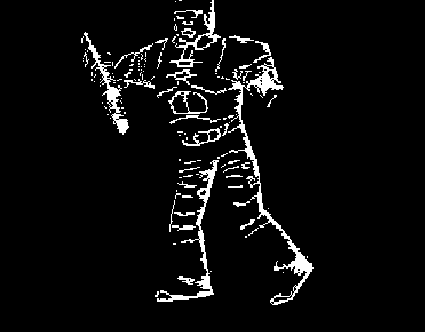| Sept. 25th to Dec. 3rd 1999 |
Despite their enormous economic and social relevance, on-line games today still have the reputation of being useless and are being affiliated with the slacker generation. These games however make the modifications in handling new media evident and are at the same time a good example for the structure of the World Wide Web and the emerging virtual communities.
The exhibition RELOAD offers three levels of exploration of this topic:
Stefan Wieland confronts the visitors with a walkover installation in real space, then, passing by (real) models of game architecture by Astrid Herrman, one gets to the new virtual environments for the computer game "Quake” created by Tom Ehninger, Holger Friese, Christine Meierhofer and NoRoomGallery.
In the exhibition space a setup of 4 computers, connected via local network, allows the audience to experience a walk through those levels created by the artists. Other players can join in via the Internet. On the RELOAD Game server the virtual artworks are ready for download - a maximum of 16 players can log in at the same time, visit and play the Quake levels around the clock.
 |
|
| Theory |
In the computer culture the idea of the maze offers a new descriptive model for data in cyberspace. In the labyrinth spaces, designed according to a narrative, propose a journey in which the public becomes the protagonist. This starts with the Renaissance domes by Brunelleschi or Mantegna, proceeding to computer games such as Sim City, Quake, Myst, as well as casinos, entertainment parks, the Futurama (world exhibitions in New York of 1939 and 1964), strategy simulations, and installation spaces in galleries and museums. All of which are variations of walkable anamorphic places – it is not a coincidence that the walk through a shopping center resembles a computer game.
By entering the maze one has to give up control and obey given rules, which must be followed in a certain way in order to succeed. This is where computer games develop the notion of religious rituals. Especially when many fellow players gather over an on-line connection the operating in the game becomes somewhat habitual. A community feeling is being experienced.
The network and all the digital toys which provide a dive into the realm of the possibilities and a discharge from the modern faith in the fragile objectivity produce an enthusiastic proneness to the superficial, the phenomena themselves. Like in pop-culture they consist of short, intensive moments, which are quickly forgotten; however by multiplication of narrative perspectives, awareness for the relativity of the interaction processes is made possible.
|
|
| Quake |
The great classic of the so-called first-person-shooters, Quake, was released in 1996 and revolutionized the gaming sector both with its modular game engine and its on-line multiplayer mode.
Being the first genuine 3-D game, Quake defined a category for itself, not least because of its extensive possibilities for editing that lead up to its still increasing popularity. The free publication of the source code on the Internet made it possible for the users to design custom levels with the aid of simple software tools; beyond that fans and players programmed hundreds of small, partially very strange modifications and extensions.
Figures of pop-culture e.g. Sailor Moon, a Japanese Manga Heroine, Batman, Beavis and Butthead, Pamela Anderson, Cartman from the series of Southpark, etc. are constantly being recycled as new player models/opponents and merged into the game. All of which is communicated via websites of fans and clans and can be downloaded for free.
Newer games and versions, such as Quake3, Unreal or Halflife, which are mainly based on an extended Quake-engine, do not change the game's basic idea "how to move or to behave successfully to survive". They mainly show improved graphics/rendering capabilities (fog!) and are provided with extended possibilities for interaction/communication.
A fast growing underground community is being established which maintains its own rules and speaks its own language. The commercial value of this community is slowly being discovered by the industry. In the U.S. sponsors from the computer- and entertainment business have been striving around this scene for quite a while, arranging and sponsoring competitions (the Quake world champion won a Ferrari) or LAN parties. In Germany on-line players only begin to appear on the radar screen of the large media companies (Bertelsmann's "Game Channel", "Web Player" by Saturn). Here the transition from a subculture phenomenon into a mainstream community, which is relevant for advertising, has just begun.
The exhibition was supported by:
 www.502.org www.502.org
Suzi Greiner
Gregor Jansen
Jens & Friends
Fa. Kluwe
Michael Onnen/Topsid
Michael Messner
 mint interactive media mint interactive media
 Quad Design Quad Design
|
|